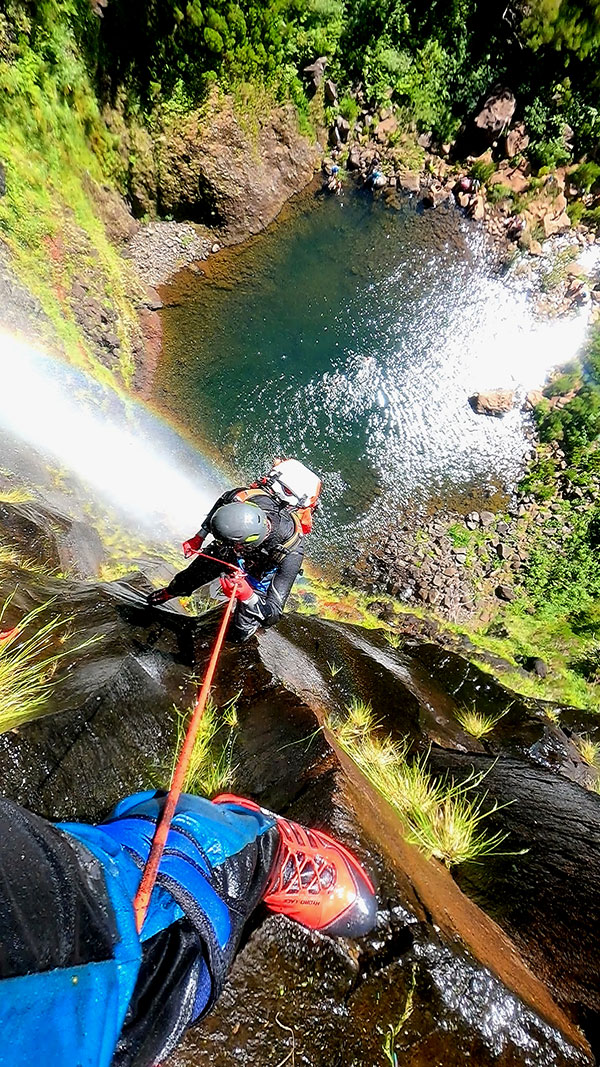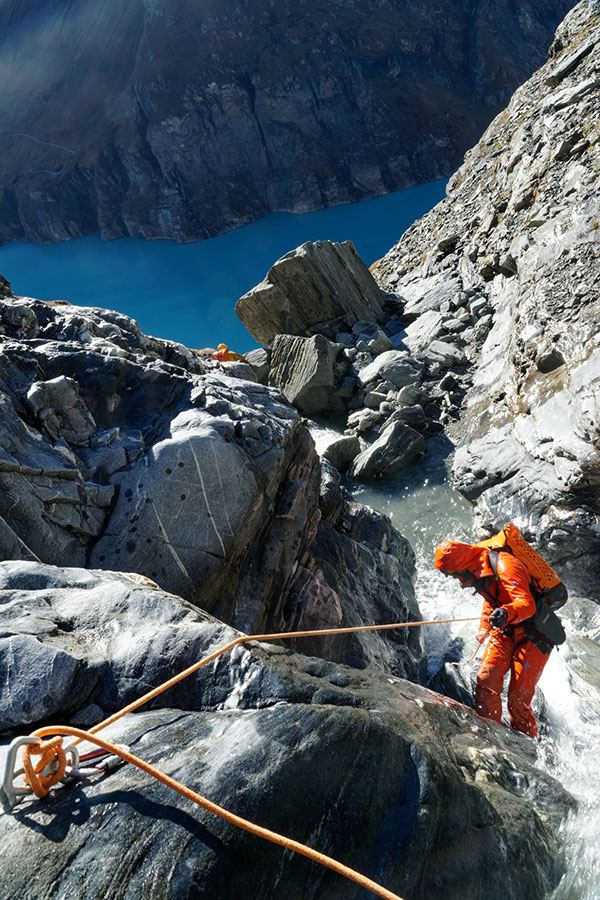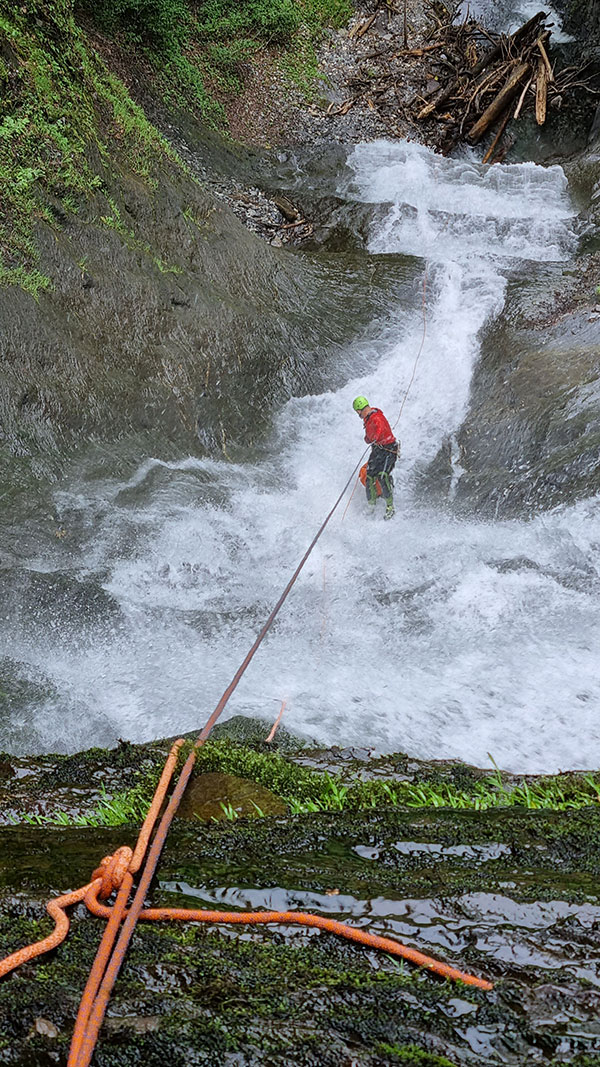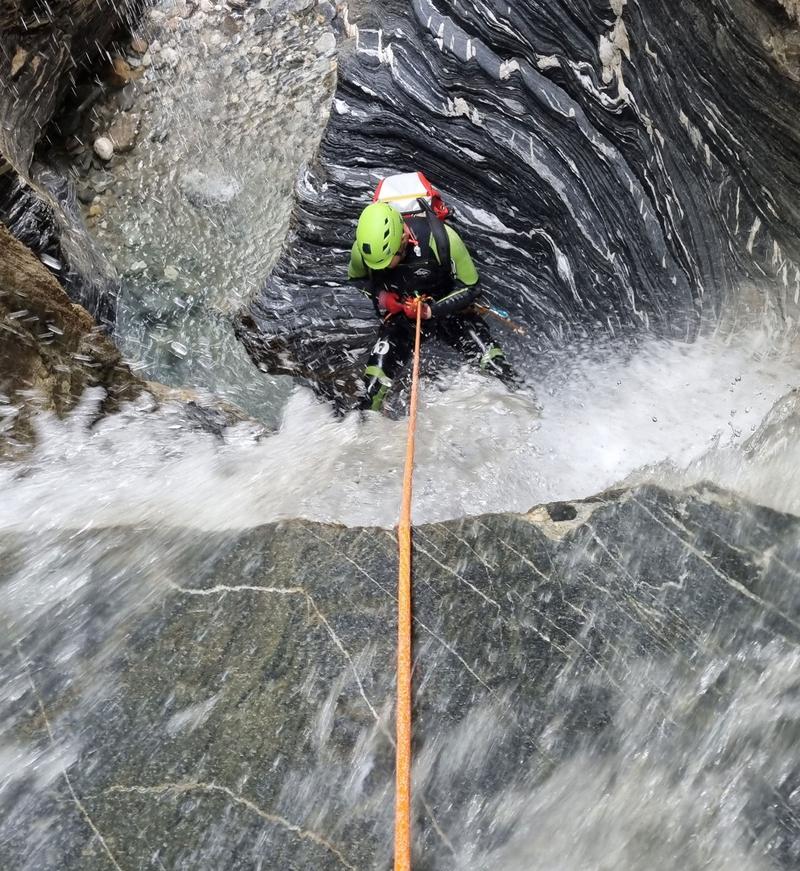Canyoning has evolved and developed a lot since the first canyon descents.
Movement and rigging techniques have changed and are suitable to modern practice, and equipment development has come a long way to having specialized canyoning descenders, shoes, wetsuits, backpacks etc… When it comes to canyoning ropes though, evolution has been considerably slower. This development has been limited mostly due to the generally-unsuitable EN1891 standard, most manufacturers are stuck with the Polyamide (Nylon) sheath/core combination. And besides the Unicore weaving that binds the sheath to the core, no serious development happened in the last 20 years. Of course that was the situation in Europe, while in the USA manufacturers unrestricted by the EN1891 were able to produce more advanced ropes using fibers like Dyneema, Technora and Aramid.
At V7 we try to follow the latest developments in canyoning, whether it is technique or equipment. Therefore we were very excited to find out that a European manufacturer has broken the still stand in canyoning ropes. You can read more about how there has not been any serious evolution on canyoning ropes on our previous blog post and also the results of his canyoning rope abrasion test. So there is finally a European (Swiss) made canyoning rope that goes beyond the Polyamide (Nylon) sheath/core combination.
CE4Y Thick Line Overview
The ropes are made by CE4Y and they offer three rope diameters 8.7mm, 9mm and 10.5mm. The 9mm one has a Dyneema/Aramid sheath and a Polypropylene core and the other two are both made with a Dyneema/Polyester sheath and a Polypropylene core.

We opted to buy and test the 10.5mm one since we intended to also test the rope in professional / guiding environment and usually companies and professionals opt for 10mm or thicker ropes, for extended endurance. In that way we would be able to compare the performance of the test rope to similar diameter ropes. Furthermore the 10.5mm Thick line rope from CE4Y was the best performing rope in the abrasion test.
Its nominal MBS is 20.5KN and it weighs a very slim 56 grams per meter, a good 20% less than most Nylon ropes of similar diameter. That means a serious weight reduction that we felt on our backs on canyons with long approaches…
It is more expensive than similar diameter Polyamide ropes at 2.75 euros per meter, but considerably cheaper than other ropes with abrasion resistant fibers from American manufacturers.
We got the rope in early May and now after six months and a full canyoning season we are ready to share our impressions.
CE4Y Thick Line - Handling and knotability
New out of the box and for a couple of outings the rope was a bit slippery and friction on the descender had to be adjusted to compensate for the fact. But soon the rope sheath got its “normal” friction which has been constant ever since. Also after the first couple of cycles of the rope getting wet and dried it lost a bit of its suppleness but has remained quite soft to handle and easy to knot and unknot after loading.

We were not able to notice any shrinkage of the rope after getting wet and dried. In addition the rope floats quite well and also its color makes it easy to locate, even in dark pools of water. It is also quite photogenic.
Rappelling
Given its diameter and the material of the sheath the rope has a lot of friction and probably lighter canyoners would opt for a lower friction mode for a smooth descent, but with option to always add friction on the go.
Interestingly, experienced canyoners, used to rappelling with the usual more stretchy Nylon ropes, initially found rappelling with this very low stretch rope a bit “strange”, but a few rappels afterwards everybody was happy with the low stretch, especially on long pitches were the stretching of a rope is more profound.
In general performing mid-rope maneuvers like locking-off or ascending was very smooth and the rope performed very well.
Durability
The promised and expected durability has been the thing we have mostly been excited about. To try and make things hard for the Thick-line rope we “mishandled” the rope, meaning we mostly didn’t use any abrasion management techniques (a couple of times habit prevailed☺) where we normally would have. In addition we also used the rope with inexperienced canyoners that are more likely to be less delicate when rappelling.
So after our season canyoning with the rope we have no damage or visible or tactile abrasion to report whatsoever. Even though this is not a comparison test (we would have to use a nylon rope at the same exact locations and in the same way in order to be able to compare the abrasion on both ropes), by experience we would be expecting to have damage or severe abrasion in more than one parts of a Semi static canyoning rope for the same amount and type of use.
Considerations while using the rope
The only issue we had to manage while using the rope was a small slippage (2cm) of the core out of the sheath which happened after the first few uses. This happened twice, not in the last couple of months though, and after contacting the manufacturer about it we were told that the binding of Dyneema and Polypropylene is not very strong and is the reason for this issue. But in any case cutting away the excess part of the core and melting the ends solves the problem.

Another thing to consider while using the rope is that the rope is made from stronger fiber than the mostly used Nylon. That is a plus on durability and strength but that also makes the rope more difficult to cut in an emergency. So we have to be sure that our knife’s edge is not dull or consider using scissors for rope cutting in an emergency.
But in reality the only “problem” with this rope is that it doesn’t comply with the EN1891 rope standard. This has nothing to do with the rope’s quality or performance, but with the unsuitability of the existing norms to the demands of modern canyoning and the evolution of material technology. And while many canyoneers chose to buy this or other ropes that don’t comply with the EN1891 norm, some may still feel reluctant to do so due to the lack of certification. And while such ropes would be ideal for professionals and canyoning providers, due to the heavy use those ropes can handle, they should actually not use them, since they don’t comply with the EN1891 and are legally not considered as PPE.
Conclusion
The CE4Y 10.5mm Thick-line rope is an advanced canyoning rope, the first one of its kind made in Europe, using high-resistance fibers like Dyneema, Aramid and Polyester. It is lightweight, floating, non-shrinking and good to handle.
Due to its high resistance fiber combination and very low stretch it has shown very good resistance to abrasion, significantly more than what we have seen with Polyamide ropes. It is definitely a rope to last for many canyoning seasons.
The production of such advanced ropes in Europe raises again the issue of the adequacy and suitability of the existing EN1891 to the demands of modern canyoning practice. We hope that an effort from the UIAA to create a standard for advanced fiber static ropes will help more manufacturers join this market segment.
Note
Responding to our feedback CE4Y informed us that they have worked to reduce the sheath slippage issue reported and now use a different Polypropylene supplier with much better results.



